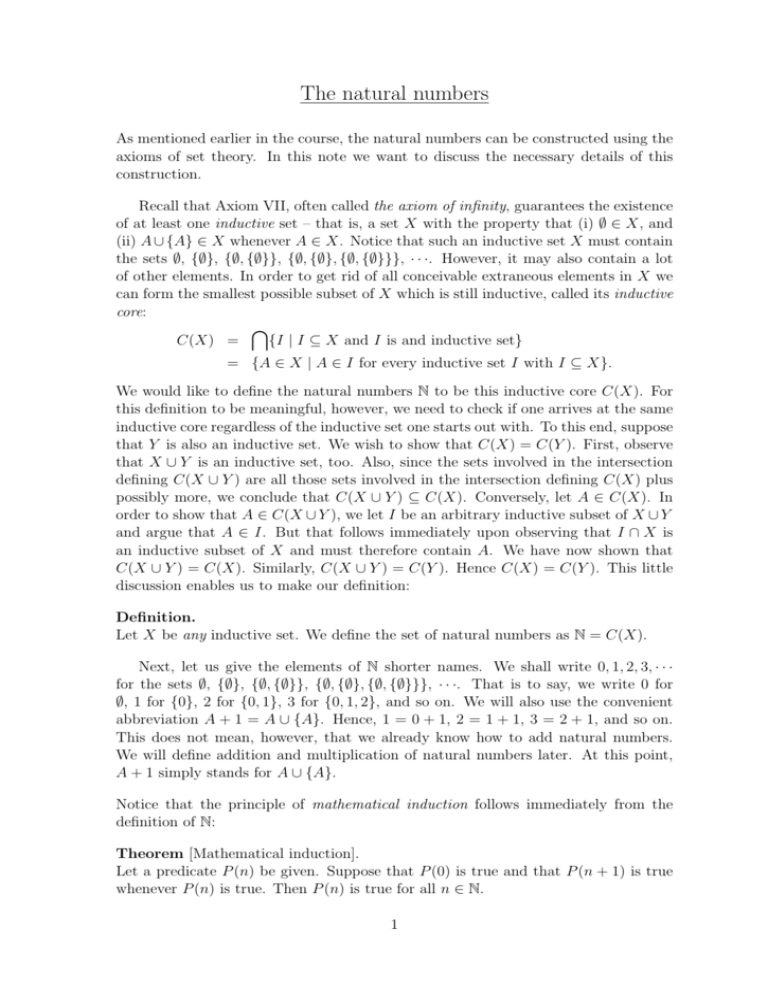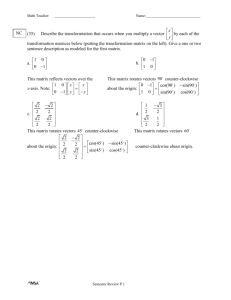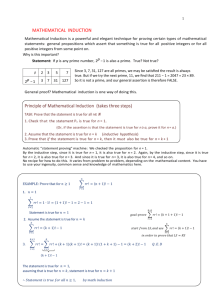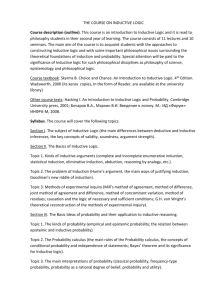The natural numbers
advertisement

The natural numbers
As mentioned earlier in the course, the natural numbers can be constructed using the
axioms of set theory. In this note we want to discuss the necessary details of this
construction.
Recall that Axiom VII, often called the axiom of infinity, guarantees the existence
of at least one inductive set – that is, a set X with the property that (i) ∅ ∈ X, and
(ii) A ∪ {A} ∈ X whenever A ∈ X. Notice that such an inductive set X must contain
the sets ∅, {∅}, {∅, {∅}}, {∅, {∅}, {∅, {∅}}}, · · ·. However, it may also contain a lot
of other elements. In order to get rid of all conceivable extraneous elements in X we
can form the smallest possible subset of X which is still inductive, called its inductive
core:
\
C(X) =
{I | I ⊆ X and I is and inductive set}
= {A ∈ X | A ∈ I for every inductive set I with I ⊆ X}.
We would like to define the natural numbers N to be this inductive core C(X). For
this definition to be meaningful, however, we need to check if one arrives at the same
inductive core regardless of the inductive set one starts out with. To this end, suppose
that Y is also an inductive set. We wish to show that C(X) = C(Y ). First, observe
that X ∪ Y is an inductive set, too. Also, since the sets involved in the intersection
defining C(X ∪ Y ) are all those sets involved in the intersection defining C(X) plus
possibly more, we conclude that C(X ∪ Y ) ⊆ C(X). Conversely, let A ∈ C(X). In
order to show that A ∈ C(X ∪ Y ), we let I be an arbitrary inductive subset of X ∪ Y
and argue that A ∈ I. But that follows immediately upon observing that I ∩ X is
an inductive subset of X and must therefore contain A. We have now shown that
C(X ∪ Y ) = C(X). Similarly, C(X ∪ Y ) = C(Y ). Hence C(X) = C(Y ). This little
discussion enables us to make our definition:
Definition.
Let X be any inductive set. We define the set of natural numbers as N = C(X).
Next, let us give the elements of N shorter names. We shall write 0, 1, 2, 3, · · ·
for the sets ∅, {∅}, {∅, {∅}}, {∅, {∅}, {∅, {∅}}}, · · ·. That is to say, we write 0 for
∅, 1 for {0}, 2 for {0, 1}, 3 for {0, 1, 2}, and so on. We will also use the convenient
abbreviation A + 1 = A ∪ {A}. Hence, 1 = 0 + 1, 2 = 1 + 1, 3 = 2 + 1, and so on.
This does not mean, however, that we already know how to add natural numbers.
We will define addition and multiplication of natural numbers later. At this point,
A + 1 simply stands for A ∪ {A}.
Notice that the principle of mathematical induction follows immediately from the
definition of N:
Theorem [Mathematical induction].
Let a predicate P (n) be given. Suppose that P (0) is true and that P (n + 1) is true
whenever P (n) is true. Then P (n) is true for all n ∈ N.
1
Proof.
Let A = {n ∈ N | P (n) is true }. Then 0 ∈ A and n + 1 ∈ A whenever n ∈ A. Hence,
A is an inductive set, so that N = C(A) ⊆ A ⊆ N. That is A = N.
We now put an ordering on the natural numbers:
Definition.
For m, n ∈ N we define m < n to mean m ∈ n.
For example, 3 < 5 since 3 ∈ 5 = {0, 1, 2, 3, 4}.
Exercises.
Use mathematical induction to prove the following statements for all m, n, k ∈ N.
[Solutions are sketched at the end of this note.]
1. m < n + 1 if and only if either m < n or m = n.
2. m ⊆ n if and only if either m < n or m = n.
3. If m < n, then m 6= n.
4. Writing m ≤ n for “m < n or m = n”, we get:
(i) n ≤ n.
(ii) If m ≤ n and n ≤ m, then m = n.
(iii) If m ≤ n and n ≤ k, then m ≤ k.
(iv) If m < n and n < k, then m < k.
5. If m < n, then m + 1 < n + 1.
6. Exactly one of the following must be true: m < n, m = n, or n < m.
7. If m + 1 = n + 1, then m = n.
Theorem [Recursion Theorem].
Let A be a set, a ∈ A, and r : N × A → A any function. Then there exists a function
f : N → A such that (i) f (0) = a, and (ii) f (n + 1) = r(n, f (n)) for all n ∈ N.
We say that the rule r together with the initial value a recursively define the
sequence f .
Proof.
T
Put f = {S ⊆ N×A | (0, a) ∈ S ∧∀n∀x[(n, x) ∈ S → (n+1, r(n, x)) ∈ S]} ⊆ N×A.
Then (i) (0, a) ∈ f and (ii) ∀n∀x[(n, x) ∈ f → (n + 1, r(n, x)) ∈ f ]. Therefore, once
we have shown that f is a function it will automatically have properties (i) and (ii)
of the theorem. (A quick induction argument shows that the domain of f is N.) We
2
will prove by induction on m that f passes the “vertical line test” and is therefore a
function: (m, x1 ), (m, x2 ) ∈ f → x1 = x2 .
Basic Step: Suppose there are (0, x1 ), (0, x2 ) ∈ f with x1 6= x2 . Then either
x1 6= a or x2 6= a. Say, x1 6= a. Form the set S = f \ {(0, x1 )} ⊆ N × A. Observe that
(i) (0, a) ∈ S, and (ii) that if (n, x) ∈ S, then (n, x) ∈ f so that (n + 1, r(n, x)) ∈ f .
Hence, (n + 1, r(n, x)) ∈ S, because (n + 1, r(n, x)) 6= (0, x1 ) (since n + 1 6= 0). So,
by definition of f , f ⊆ S. This contradicts the definition of S.
Inductive Step: Suppose that (m + 1, x1 ), (m + 1, x2 ) ∈ f with x1 6= x2 . If both
x1 = r(m, z1 ) for some (m, z1 ) ∈ f and x2 = r(m, z2 ) for some (m, z2 ) ∈ f , then
z1 = z2 by inductive hypothesis, so that x1 = x2 – which is not the case. We can
therefore assume, without loss of generality, that x1 6= r(m, z) for all (m, z) ∈ f .
Form the set S = f \ {(m + 1, x1 )} ⊆ N × A. As before, observe that (i) (0, a) ∈ S
(since 0 6= m+1) and (ii) that if (n, x) ∈ S, then (n, x) ∈ f so that (n+1, r(n, x)) ∈ f .
Hence, (n + 1, r(n, x)) ∈ S (otherwise m + 1 = n + 1 and x1 = r(n, x) = r(m, x)
with (m, x) = (n, x) ∈ f , which is not allowed). The definition of f implies now that
f ⊆ S, which in turn contradicts the definition of S. This completes the proof.
We now use the recursion theorem to introduce addition and multiplication into
our set of natural numbers.
First we want to define what it means to add a natural number to a fixed m ∈ N.
We do this by recursively defining a function fm : N → N. We require that
(i) fm (0) = m; and
(ii) fm (n + 1) = fm (n) + 1.
The recursion theorem guarantees the existence of such a function fm . We will of
course write m + n for fm (n). (Notice that fm (1) = fm (0) + 1 = m + 1 so that there
is no ambiguity in using “m + 1” for both “m ∪ {m}” and “fm (1)”.) In this more
suggestive notation, the above two items read:
(i) m + 0 = m; and
(ii) m + (n + 1) = (m + n) + 1.
Exercises.
8. Show that (m + n) + k = m + (n + k) for all m, n, k ∈ N.
9. Show that m + n = n + m for all m, n ∈ N.
3
We also define multiplication of a fixed m ∈ N by a natural number via the
recursion theorem by way of a function gm : N → N with the properties
(i) gm (0) = 0; and
(ii) gm (n + 1) = gm (n) + m.
Writing m · n for gm (n), this recursive definition can be written as
(i) m · 0 = 0; and
(ii) m · (n + 1) = m · n + m.
Here, we make the usual convention that multiplication is carried out before addition,
unless specified otherwise.
Exercises.
Prove the following for all m, n, k ∈ N.
10. m · 1 = 1 · m = m.
11. (m + n) · k = m · k + n · k.
12. m · n = n · m.
13. (m · n) · k = m · (n · k).
14. If m < n, then m + k < n + k.
15. If m < n and k 6= 0, then m · k < n · k.
16. If m · k = n · k and k 6= 0, then m = n.
17. If m + k = n + k then m = n.
18. If m · n = 0, then either m = 0 or n = 0.
19. If m ≤ n, then there is exactly one d ∈ N such that m + d = n.
4
Solutions.
1. This follows straight from the definition of n + 1 = n ∪ {n} and the meaning of
the symbol “<”.
2. “⇐” We will prove, by induction on n, that m < n implies m ⊆ n. The case
n = 0 is vacuously true. Now suppose that m < n + 1. Then either m < n
or m = n, by Exercise 1. Hence, by the inductive hypothesis, m ⊆ n, so that
m ⊆ n ∪ {n} = n + 1. “⇒” Once more, we induct on n. If n = 0, then
m = ∅ = n. Inductively, suppose that m ⊆ n + 1 = n ∪ {n}. If n 6∈ m, then
m ⊆ n, so that by inductive hypothesis either m = n or m < n. Either way,
this case implies that m ∈ n ∪ {n}, i.e. m < n + 1. On the other hand, if n ∈ m,
then n ⊆ m by the first part of this proof. So, m = n ∪ {n} = n + 1.
3. We show by induction on n that n 6∈ n for all n ∈ N. Clearly, 0 6∈ 0 = ∅, so
that the statement is true for n = 0. Next, assuming that n 6∈ n, we wish to
prove that n + 1 6∈ n + 1. Suppose to the contrary that n + 1 ∈ n + 1. Then
n + 1 < n or n + 1 = n by Exercise 1. If n + 1 < n, then n ∪ {n} = n + 1 ⊆ n
by Exercise 2. This implies n ∈ n; a contradiction. The alternative, n + 1 = n,
implies the same contradiction.
4. By Exercise 2, m ≤ n if and only if m ⊆ n.
5. We induct on n. The basic step is vacuously true. Now suppose that m < n + 1.
We need to show that m + 1 < (n + 1) + 1. By Exercise 1, either m = n or
m < n. In the first case, m + 1 = n + 1 < (n + 1) + 1. In the second case,
the inductive hypothesis implies that m + 1 < n + 1 < (n + 1) + 1. Hence,
m + 1 < (n + 1) + 1 by Exercise 4 (iv).
6. By Exercises 2 and 3, at most one of the three alternatives is possible. To show
that at least one of them occurs, we induct on n. If n = 0, then n ≤ m. (A
quick induction shows that 0 ≤ k for all k ∈ N.) Our inductive hypothesis
is now that either m < n, m = n, or n < m. We need to show that either
m < n + 1, m = n + 1, or n + 1 < m. If m = n, then m < n + 1. If m < n,
then m < n < n + 1. Lastly, if n < m, then n + 1 < m + 1 by Exercise 5. So,
by Exercise 1, either n + 1 < m or n + 1 = m.
7. Follows from Exercises 5 and 6.
8. We induct on k. If k = 0, then (m+n)+0 = m+n = m+(n+0). Assuming that
def
I.H.
the statement holds for k, we compute (m + n) + (k + 1) = [(m + n) + k] + 1 =
def
def
[m + (n + k)] + 1 = m + [(n + k) + 1] = m + (n + (k + 1)).
9. (a) First we prove, by induction on m, that m + 0 = 0 + m. The basic step
is a triviality: 0 + 0 = 0 + 0. Here is the inductive step: (m + 1) + 0 =
#8
I.H.
m + 1 = (m + 0) + 1 = (0 + m) + 1 = 0 + (m + 1).
5
(b) Next we show, by induction on m, that m+1 = 1+m. We can use Part (a)
for the basic step: 0+1 = 1+0 (although this also follows straight from the
I.H.
def
definitions). The inductive step is as follows: (m + 1) + 1 = (1 + m) + 1 =
1 + (m + 1).
(c) Now we prove, by induction on n, that m + n = n + m. We did the
def
basic step in Part (a). The inductive step is as follows: m + (n + 1) =
(b)
#8
I.H.
def
(m + n) + 1 = (n + m) + 1 = n + (m + 1) = n + (1 + m) = (n + 1) + m.
def
#9
def
10. First notice that m · 1 = m · (0 + 1) = m · 0 + m = 0 + m = m + 0 = m. So
we only have to show that 1 · m = m also. One shows this by induction on m.
The basic step follows from the definition: 1 · 0 = 0. The inductive step is as
def
I.H.
follows: 1 · (m + 1) = 1 · m + 1 = m + 1.
def
11. Induct on k.
Here is the inductive step: (m + n) · (k + 1) =
#10+I.H.
#9+def
(m + n) · k + (m + n) = m · k + n · k + m · 1 + n · 1 = m · (k + 1) + n · (k + 1).
def
12. Induct on n. Here is the inductive step: m · (n + 1) = m · n + m
#11
n · m + 1 · m = (n + 1) · m.
I.H.+#10
def
=
I.H.
13. Induct on k. Here is the induction step: (m · n) · (k + 1) = (m · n) · k + m · n =
#11,12
def
m · (n · k) + m · n = m · (n · k + n) = m · (n · (k + 1)).
14. Induct on k, using Exercise #5.
15. Using the previous exercises, this is an easy induction on k.
16. The contrapositive of this statement follows immediately from Exercises #6 and
#15.
17. In conjunction with Exercise #7, this is a straight forward induction on k.
18. We prove the contrapositive: suppose m 6= 0 and n 6= 0. Since n < 0 (i.e.
n ∈ ∅) is impossible, then, by Exercise #6, 0 < n. Hence, by Exercises #15 and
#12, 0 = m · 0 = 0 · m < n · m = m · n, so that m · n 6= 0 (again by Exercise #6).
19. We only have to show the existence of such a d, uniqueness follows from Exercise #17. This is most easily done with an induction on n. If n = 0, then
m = 0 and we can take d = 0. Now suppose that m ≤ (n + 1). We will show
that there is a d ∈ N such that m + d = n + 1. If m = n + 1, we take d = 0. If
m < n + 1, then m ≤ n by Exercise #1. We then use the inductive hypothesis
to get a c ∈ N with m + c = n and take d = c + 1.
6









